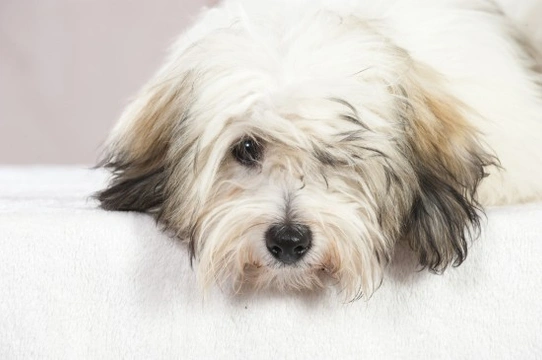
Coton de Tulear hereditary health and genetic diversity
The Coton de Tulear dog is a small, fluffy little dog, so named for the cotton-like texture of its coat. While the most common colour for the breed is white, the dog can also be seen in black, or tricolour black, white and tan too, and the texture of their fur is more like hair than actual fur.
They are classed as a small dog breed, which can weigh between 3.5-6kg, and stand up to 11.8” tall at the withers. While the number of Coton de Tulear dogs owned in the UK is much lower than that of other small breeds such as the Bichon Frise, the Coton de Tulear is becoming ever more popular here, thanks to their bright, friendly personalities, robust health, and unique coats.
The hair of the coat is non-shedding, and is considered to produce low amounts of dander, making them worthy of consideration for people who may be prone to allergies to most other types of dogs. They are also reputed to be very clean and not prone to developing a “doggy” smell, although their coats do need a significant amount of grooming and occasional bathing to keep them in good condition.
If the Coton de Tulear is a breed of dog that you are considering buying, it is important to research the care and wellness of the breed in depth, and this includes finding out the basics of the breed’s hereditary health and wellness, and their average longevity. In this article, we will cover these factors in more detail. Read on to learn more.
Coton de Tulear longevity
The Coton de Tulear is one pedigree breed that does not suffer from as wide a range of hereditary defects as many others, and over all, they are considered to be healthy, long lived dogs.
The average longevity of the Coton de Tulear is 14-19 years, placing them well above the average for dogs of a similar size of other breeds.
Genetic diversity and health testing for the Coton de Tulear
The coefficient of inbreeding statistic for the Coton de Tulear is 5.7%, which is relatively low for a pedigree dog breed. A figure of 6.25% or lower is considered to be desirable for pedigree dogs as a whole, and at 5.7%, the Coton de Tulear falls well below this, and as such, is not considered to be particularly subject to inbreeding.
Despite the fact that the breed is still relatively uncommon compared to other small popular breeds, genetic diversity across the breed as a whole is wide ranging, which helps to contribute to the health and wellness of the breed, and is partially responsible for the low level of hereditary problems across the breed.
The Coton de Tulear is one of the few pedigree breeds for which no specific health schemes or areas of concern are recognised by the British Veterinary Association, however, DNA testing is possible for the breed, with an eye to identifying a couple of specific problems.
Prior to breeding the Coton de Tulear, breeders are recommended to undertake DNA testing on their parent dogs for neonatal ataxia, canine multifocal retinopathy, and Type One Von Willebrand’s disease.
Coton de Tulear conformation
Again, the breed standard for conformation and physical features for the Coton de Tulear is not considered to place the breed at risk of any complications or problems due to their build and body shape.
Once consideration that owners should bear in mind, however, is the coat of the breed, and how much maintenance it needs on an ongoing basis is often overlooked. The head hair should be kept trimmed above the eyes to ensure that it does not obscure vision, and the coat as a whole should be kept well groomed, and trimmed if necessary.
Because the coat of the breed is non-shedding, dirt, debris and muck can build up within the coat over time, which is why daily brushing and grooming is vital, and occasional baths are recommended.
Health issues within the breed
While the Coton de Tulear is a considerably long lived breed that is not considered to be high profile or of particular cause for concern in terms of their health, like all dog breeds, this does not guarantee perfect health in any given dog of the breed! The Coton de Tulear does not have an overly long list of potential conditions that are thought to be hereditary across the breed, but there are a couple of potential conditions that can be seen within the breed as whole. These include:
- Retinopathy, a disease of the retina of the eye that can cause loss of vision or obstruction of normal vision.
- Cerebellar ataxia, which leads to an abnormal development of the hind brain. This can cause problems such as a lack of coordination, muscle weakness and tremors.



